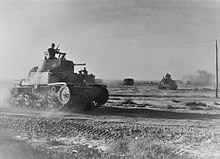M13 / 40
| M13 / 40 | |
|---|---|

M13 / 40 in a museum in Bovington, UK |
|
| General properties | |
| crew | 4 (commander, driver, gunner, loader) |
| length | 4.90 m |
| width | 2.21 m |
| height | 2.39 m |
| Dimensions | 13.8 t |
| Armor and armament | |
| Armor | 6 (tub bottom) - 42 (tower front) mm |
| Main armament | 47 mm L / 32 cannon |
| Secondary armament | 3 Breda MGs model 38, caliber 8 mm |
| agility | |
| drive | V8 diesel Fiat -SPA 8 TM40 92 kW (125 PS) |
| Top speed | 31 km / h (road) |
| Power / weight | 6.7 kW / t (9.1 PS / t) |
| Range | 200 km |
The tank M13 / 40 (also Carro Armato M13 / 40 ) from Fiat - Ansaldo was, together with the slightly improved M14 / 41, the only battle tank produced in significant numbers by Italy during World War II . A total of about 1500 pieces of both types were produced. The M13 / 40 achieved a top speed of 31 km / h with an engine of 125 hp and a range of 200 km. The maximum armor of the tower and the bow front was 40 mm, the total weight almost 14 tons. The armament consisted of a 47 mm L / 32 gun and three Breda - guns of caliber 8 mm. Four men made up the crew.
In terms of armament, both the M11 / 39 with its (hardly swiveling) 37 mm on-board cannon and especially the M13 / 40 with the 47-mm on-board cannon were initially up to date. In the summer of 1940 no Allied battle tank was equipped with an on-board cannon with a caliber of more than 47 mm, as the French Char-B1 tanks were completely destroyed or captured during the French campaign (see also German Panzerkampfwagen III ). However, the M13 / 40 was insufficiently armored and motorized from the start. An attempt was made to remedy this problem with the versions M14 / 41 and M15 / 42 , which improved the engine, but were delivered too late. In use, attempts were usually made to improve the weak armor by attaching sandbags.
The M3 Lee / Grant and M4 Sherman tanks used by the Allies from 1942 onwards were no longer up to the M13 / 40 and its improved variants. Nevertheless, the Italian armored divisions " Ariete " and " Littorio " at El Alamein , as well as the armored division " Centauro " in Tunisia fought with these tanks until the end. The Semovente 75/18 assault gun with a 75 mm cannon on an M13 chassis, which was used quite effectively as a main battle tank, was now used to support the M13 .
As a further development of the M13 / 40 , the M14 / 41 was created with a more powerful engine, later the M15 / 42 with improved main armament.
After the Italian armistice, the vehicles were still sparsely built under German direction, but in 1944 they were considered obsolete (basically they were already when they were introduced) and were replaced in production by the M15 / 42. In September 1943, some vehicles were also captured by the Wehrmacht. These vehicles were in two SS - Sturmgeschütz departments and the "Panzer Division Adria" used for partisan warfare. They were called Sd.Kfz. 735 (i) .
nomenclature
The names of Italian tanks were based on their weight and the year of their first production or delivery. The letters L, M and P stand for leggero (easy), medio (medium) and pesante (difficult). The numbers after the letter indicate the weight in tons and then the year of development, first production or delivery.

